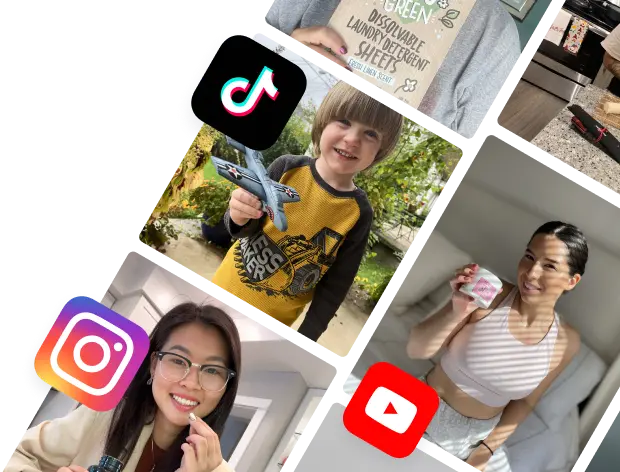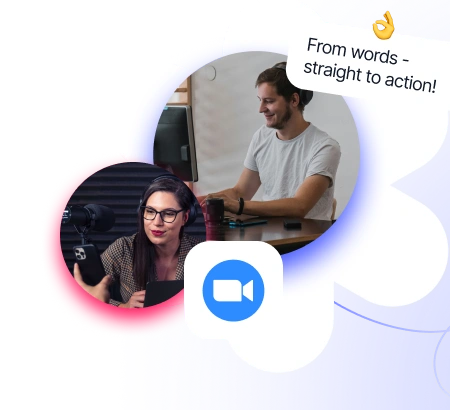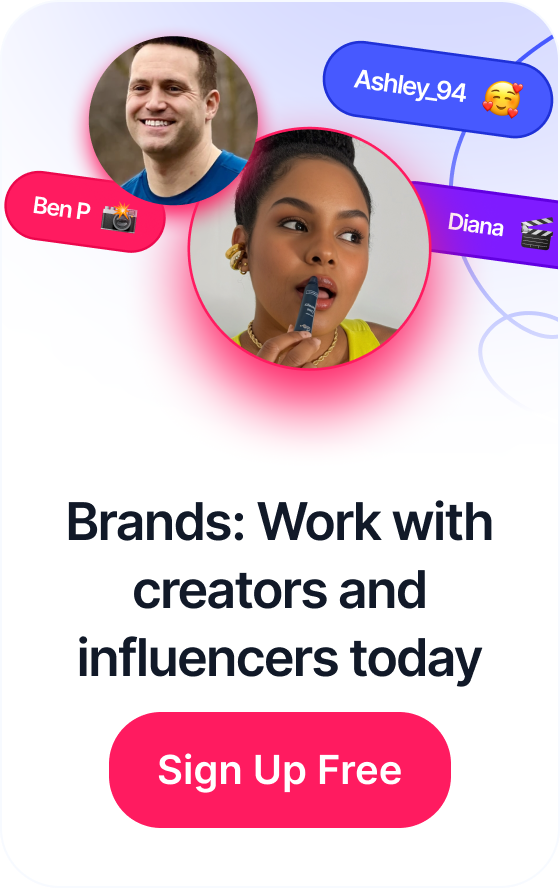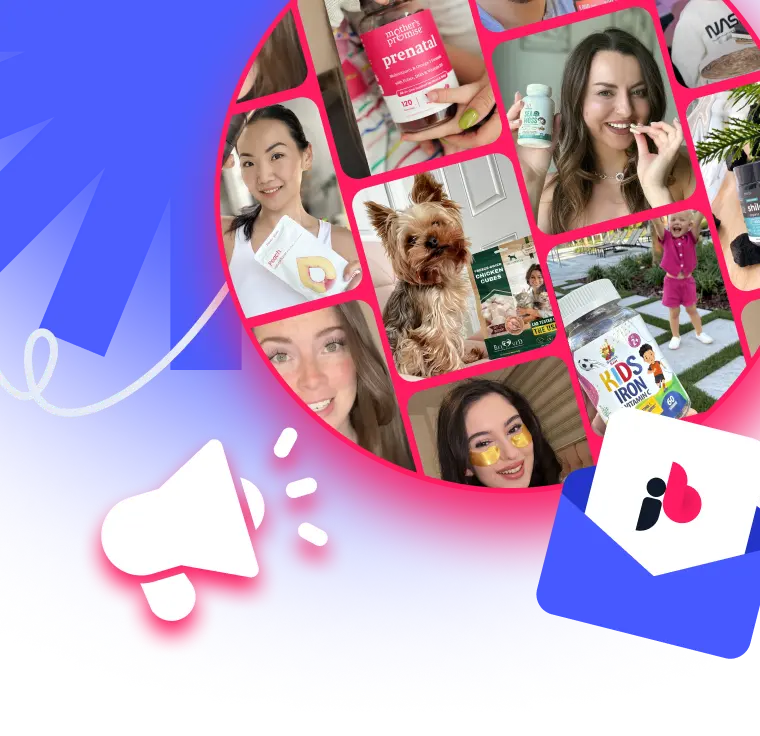 Join the TikTok Affiliate Program & Boost Your Earnings
Join the TikTok Affiliate Program & Boost Your Earnings
Finding the right TikTok influencers isn't about endless, mindless scrolling. The best partnerships I've ever seen—the ones that actually move the needle—are born from a solid strategy put in place long before anyone opens the app.
It all starts with defining your campaign goals, mapping out a detailed influencer persona, and setting KPIs you can actually measure. This groundwork is what ensures you find creators who genuinely click with your brand and deliver real results.
Table of Contents
Building Your Influencer Search Strategy
Jumping into TikTok without a plan is like wandering through a new city without a map. Sure, you might see some cool stuff, but you’re probably not going to end up where you need to be. A truly effective search for TikTok creators begins with some serious introspection and strategic planning. You have to define what success actually looks like for your brand.
This initial step is completely non-negotiable. It’s what separates the campaigns that generate a killer ROI from the ones that just drain your marketing budget. When you outline your objectives and the exact type of creator you're looking for first, you're essentially creating a powerful filter that instantly shrinks the massive pool of potential partners down to a manageable size.
Define Your Campaign Goals
First things first: what are you actually trying to accomplish? Let’s be clear, "going viral" is a wish, not a business goal. Your objectives need to be specific, measurable, and tied directly to tangible outcomes for your business. Are you trying to get your name out there with a new demographic, or are you laser-focused on driving sales for a new product launch?
The goal you choose will immediately point you toward the right type of influencer.
- Brand Awareness: For this, you might look for a creator with a massive following and a real talent for telling a compelling story. They’re perfect for introducing your brand to a huge, new audience.
- Sales and Conversions: A micro-influencer with a super-engaged, niche following could be your secret weapon here. Their audience might be smaller, but they trust their recommendations, which often translates to much higher conversion power.
- Content Generation: Sometimes, you just need a constant flow of authentic user-generated content (UGC) that you can repurpose for your own social media channels and ad campaigns.
The clearer you are about your goals from the get-go, the simpler it is to find an influencer whose content and audience actually line up with them. A mismatch at this stage is the number one reason I see campaigns fall flat.
Create Your Ideal Influencer Persona
Once your goals are locked in, it's time to build a persona for your perfect creator. This is so much more than just glancing at follower counts. I always tell clients to think of it like creating a customer persona, but for a brand partner. This profile should break down the specific qualities you’re looking for.
Here are a few key things to consider:
- Niche Relevance: Do they live and breathe your industry? If you’re a skincare brand, you should be digging into the #beautytok or #skintok communities, not trying to pitch a gaming influencer.
- Content Style and Tone: Is their vibe a match for your brand's voice? If your brand has a polished, professional feel, a creator known for chaotic, unfiltered comedy probably isn't going to be the right fit.
- Audience Demographics: Who is actually watching their videos? You have to make sure their followers match your target customer in terms of age, location, gender, and—most importantly—interests.
At the end of the day, the success of your influencer marketing relies on strong website conversion rate optimization strategies to turn all those engaged viewers into actual customers.
Finding Creators Manually on TikTok
While influencer platforms are a great shortcut, sometimes the best way to find real talent on TikTok is to just roll up your sleeves and dive into the app yourself. This hands-on method lets you discover raw, authentic creators and get a genuine feel for what’s actually resonating in your niche. When you act like a user, you get an unfiltered view of who is truly captivating your target audience.
Forget starting with a generic keyword search. The real magic happens when you learn to think like the TikTok algorithm. Your "For You" Page (FYP) is a powerful discovery engine just waiting to be trained. The more you interact with content relevant to your brand—liking, commenting, and saving videos in your niche—the more the algorithm will start feeding you similar content. In effect, it starts bringing potential creator partners directly to you.

Use TikTok's Own Discovery Tools
The platform itself has some surprisingly powerful, built-in features for sourcing talent. You just have to know how to use them strategically to find creators who are already leading the conversation in your industry. It really comes down to observing what’s working and recognizing the patterns in trending content.
Start by digging into these core features:
- Trending Hashtags: Look past the obvious tags like
#ad. You want to find niche-specific hashtags that are picking up steam, like #skintok for beauty brands or #cleantok for home goods. The creators who are all over these specific tags are often the ones seen as authorities in their space. - Trending Sounds: Pay close attention to the audio clips that keep popping up on your FYP. If you tap on a sound, TikTok shows you a whole library of videos using it. This is a goldmine for spotting creators who are quick to jump on trends while still keeping their own unique voice.
A huge mistake I see brands make is only chasing creators with massive followings. Some of the best partnerships I've ever seen came from micro-influencers who are deeply connected to a specific community and have a smaller, but incredibly engaged and trusting, audience.
See Who Your Competitors Are Working With
One of the smartest (and sneakiest) ways to find proven talent is to just look at what your competitors are doing. Don't just watch their ads—really analyze their influencer partnerships. Who are they collaborating with? What kind of content are those creators making for them, and how is the audience reacting in the comments?
This isn’t about copying their strategy. It's about gathering intel. You might identify creators who already know your market inside and out. Even better, you can spot gaps in their approach that you can take advantage of. Maybe they’re only working with huge macro-influencers, leaving a massive opportunity for you to connect with more authentic micro-creators in that same space.
This direct approach works so well because it taps into the platform's biggest strength: authentic engagement. TikTok has exploded to 1.59 billion monthly active users globally as of early 2025 because it’s all about genuine connections. Influencers on the platform pull in an average engagement rate of about 2.5%, which blows other social networks out of the water. By searching manually, you get a front-row seat to see which creators are actually driving that engagement. You can discover more insights about TikTok influencer engagement on afluencer.com.
Find Your Next Star on TikTok’s Official Creator Marketplace
Let's be real: hunting for creators manually on TikTok can feel like searching for a needle in a digital haystack. It works, but it's a grind. For a much more direct and data-driven approach, you need to be using TikTok’s own official platform: the TikTok Creator Marketplace (TTCM).
Think of it as the ultimate verified directory. It’s built from the ground up to connect brands with creators who are actively looking for partnerships. This is where you graduate from guesswork to certainty.
Instead of trying to estimate a creator's audience demographics, you get access to first-party, verified data straight from the source. You can confirm that a creator's audience truly aligns with your target customer—from their location and age all the way down to their specific interests. For campaign planning, that kind of accuracy is a game-changer.
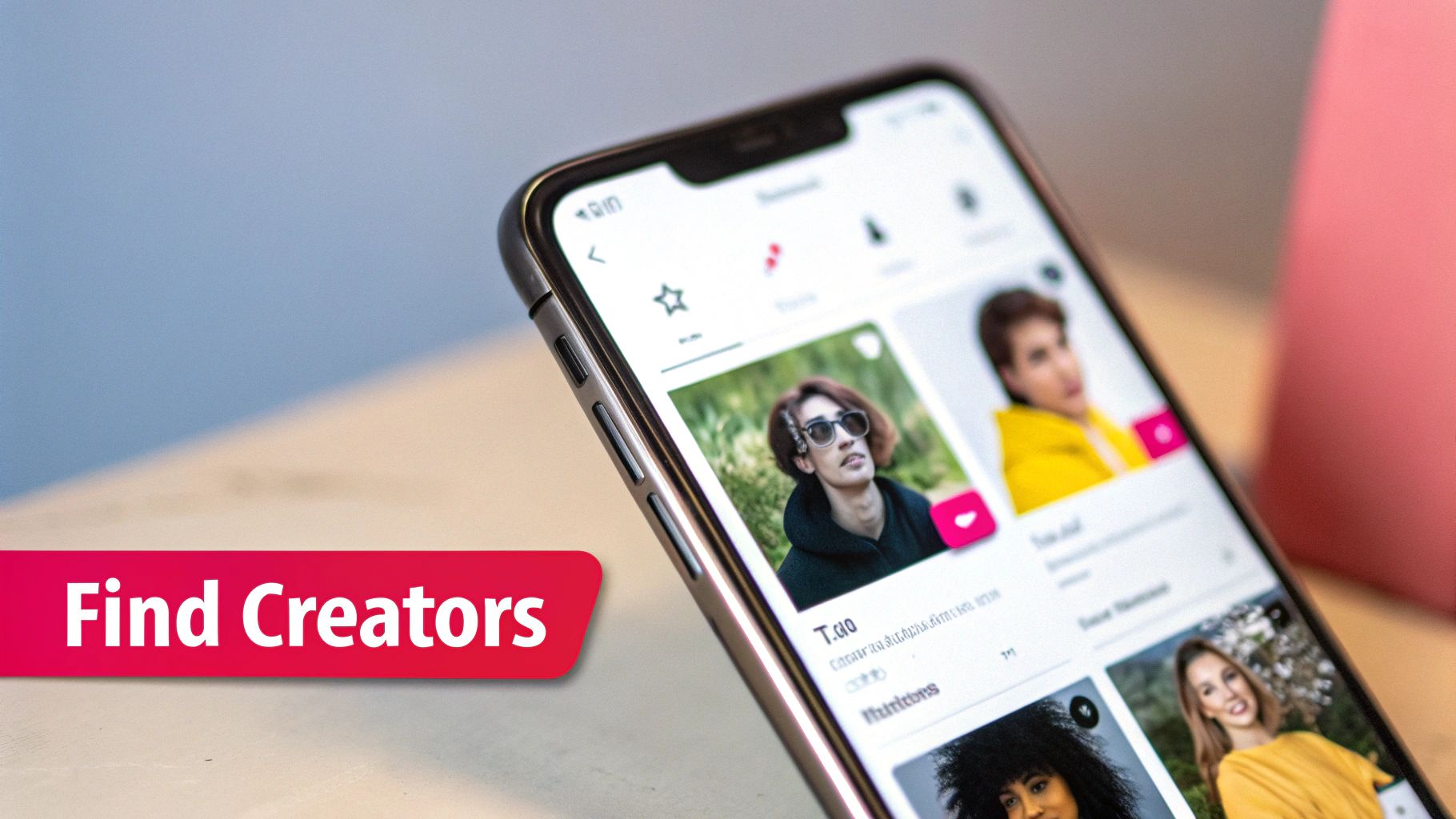
Dialing in Your Search With Marketplace Filters
The true magic of the TTCM is in its powerful filtering tools. Once you're in, you can move way beyond simple keyword searches and start pinpointing creators with surgical precision. This is where you find the perfect fit.
You can slice and dice your search by:
- Audience Demographics: Filter creators by country, specific age ranges, and gender.
- Creator Attributes: Narrow it down by follower count, average views, or content niche (like beauty, tech, or gaming).
- Performance Metrics: Find creators who hit specific benchmarks, like high engagement rates or consistent video views.
Imagine you're a sustainable fashion brand. With these filters, you could instantly find female creators in the US, aged 25-34, whose audience shows a proven interest in "eco-friendly" products and who maintain an average engagement rate over 4%. This kind of targeted search saves countless hours of vetting.
Why an Official Platform Changes the Game
Using a tool like the TTCM gives you way more than just fancy search filters. The entire campaign workflow is managed inside a secure, centralized hub, which simplifies communication and protects both you and the creator. You can handle everything from negotiations and brief sharing to content approvals, all in one spot.
One of the biggest wins here is that you're connecting with creators who have already raised their hand. They’ve actively joined the marketplace, signaling that they are ready and open for brand collaborations. That simple fact alone can dramatically boost your response rates.
This streamlined process is especially critical when you consider the sheer scale of the platform. TikTok's user base is closing in on 1.94 billion adults globally, and these users are highly engaged, spending nearly 10 minutes per session. In an ecosystem this massive, finding the right voice is everything.
The Creator Marketplace gives you the structure you need to cut through the noise and find partners who can genuinely connect with your audience. To get a better sense of who's on the platform, it's worth taking a look at some detailed TikTok demographics and user statistics on explodingtopics.com.
How to Properly Vet TikTok Influencers
Finding a TikTok creator with a huge follower count feels like a win, but honestly, that’s just the starting line. The real work—the part that actually determines your campaign's success—is in the vetting process.
This is the critical, non-negotiable step where you look past the flashy numbers and dig into the actual health of an influencer’s community. It’s how you make sure they’re the right fit for your brand and not just a black hole for your budget. Proper vetting is what separates a partnership that flops from one that drives real, measurable results.
Moving Beyond Follower Counts
The biggest mistake I see brands make is getting star-struck by a massive follower count. Sure, reach is important, but engagement is king. I’d take a creator with 50,000 highly engaged followers over one with a million passive scrollers any day of the week.
Your first move should be to calculate their true engagement rate. Don’t just take their word for it or rely on a single screenshot. Get your hands dirty and manually check their last 10-15 videos (and make sure to skip any one-off viral hits that could skew the data).
Use this simple formula:
Engagement Rate = (Total Likes + Total Comments) / Follower Count / Number of Videos x 100
On TikTok, a healthy, organic engagement rate usually lands somewhere between 3% and 7%. If you see a number significantly lower than that, it’s often a red flag for a disengaged audience or, worse, a bunch of fake followers. If the math checks out, it’s time to look at the quality of that engagement.
Auditing Audience Sentiment and Content Quality
Numbers only tell half the story. The other, more important half is hiding in plain sight: the comments section. This is a goldmine of unfiltered feedback from their community.
Are people having real conversations, tagging their friends, and asking thoughtful questions? Or is it just a wall of generic, one-word comments like "nice," "cool," or a string of fire emojis?
Here’s what you should be looking for:
- Positive Sentiment: You want to see comments that show a genuine appreciation for the creator and what they post. That’s the sign of a loyal, trusting community that will actually listen when that creator recommends your product.
- Red Flags: Be on the lookout for an excessive amount of spam, negativity, or arguments. A creator who can’t (or won’t) manage their own community is a risky partner for any brand.
Once you’ve scoped out the comments, do a quick qualitative audit of their content. Scroll back through their feed for at least a few months. Do they have a consistent style? Is their content consistently high-quality and on-brand for them? A creator with a clear point of view is far more likely to produce content for you that feels authentic, not like another forced, awkward ad. This whole process is fundamental to finding TikTok influencers who genuinely align with your brand's values.
To give you some context on budgeting, this chart breaks down the average costs you can expect when working with influencers across different platforms.
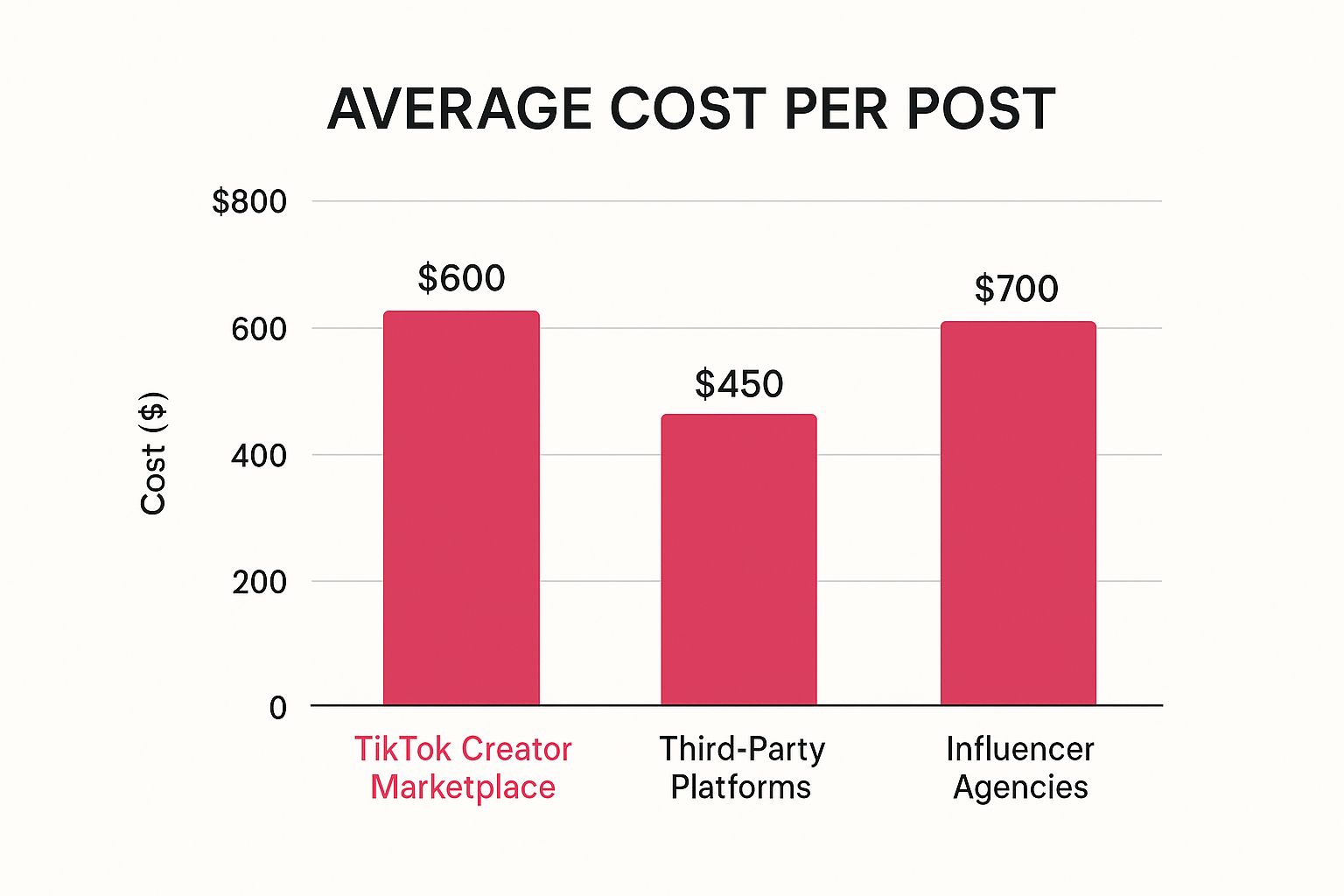
As you can see, going through an agency often comes with the highest price tag, while third-party platforms can be a more budget-friendly way to start. This financial perspective is crucial. You have to weigh an influencer's engagement quality against their cost to figure out if the potential ROI is really there.
Vetting properly means you need to distinguish between the numbers that look good and the numbers that are good. The table below breaks down the difference between vanity metrics and the actionable data you should really be focusing on.
Vanity Metrics vs Actionable Metrics for Vetting Influencers
| Metric Type | Example Metric | What It Really Tells You | Why It Matters for Vetting |
|---|---|---|---|
| Vanity | Follower Count | A measure of potential reach, but not actual engagement or influence. | Easily inflated by bots or inactive accounts; a poor indicator of community health. |
| Actionable | Engagement Rate | The percentage of followers actively interacting (likes, comments) with content. | Shows how connected an audience is. A high rate suggests a loyal, active community. |
| Vanity | Video Views | How many times a video was seen, but offers no insight into viewer sentiment. | A viral video can spike views without leading to conversions or brand affinity. |
| Actionable | Comment Sentiment | The qualitative nature of comments—positive, negative, spam, or genuine discussion. | Reveals the true relationship between the creator and their audience. Trust is built here. |
| Actionable | Audience Demographics | Data on the age, location, and interests of the influencer's followers. | Ensures the influencer’s audience matches your target customer profile. A mismatch means wasted spend. |
| Vanity | Likes per Post | A simple interaction metric that requires very little effort from the user. | Easy to fake and doesn't necessarily translate to influence or purchasing intent. |
Ultimately, focusing on actionable metrics like engagement rate and audience sentiment will give you a much clearer picture of an influencer's true value. It helps you partner with creators who can drive real results, not just big numbers.
Crafting Outreach That Gets a Response
You’ve done the hard work and pinpointed the creators who feel like a perfect match for your brand. Now comes the moment of truth: making contact. This first message is your one shot at a great first impression, and believe me, a generic, copy-pasted pitch is the fastest way to land in the "ignored" pile.
Top-tier creators are absolutely flooded with partnership requests. To cut through that noise, you have to show them you’ve actually done your homework. A thoughtful, personalized approach isn't just nice—it's necessary.
A solid pitch goes way beyond a simple compliment. It references specific content they've made. When you mention a recent video you genuinely enjoyed and explain why it hit the mark, you're proving you see them as a creative partner, not just a billboard.

Personalize Your Pitch
The best outreach feels less like a cold business proposal and more like the start of a real conversation. Forget generic flattery; it’s completely transparent and gets you nowhere. You have to get specific.
Your initial message needs to communicate three things right off the bat:
- Who you are: Clearly introduce yourself and your brand.
- Why you chose them: Reference something specific. For instance, "Your ‘unboxing fails’ series had our team laughing out loud—it’s exactly the kind of authentic humor we love."
- What the opportunity is: Briefly touch on what’s in it for them. This isn’t just about the money; it's about framing it as a partnership that actually fits their brand and content style.
This level of personalization shows you respect their craft and are looking for a true collaboration, not just a quick, transactional ad placement.
Be Clear and Transparent
At the end of the day, creators are running a business, and they appreciate people who get straight to the point. After you’ve broken the ice with your personalized intro, lay out the initial campaign details clearly and concisely. Vague requests just create a frustrating back-and-forth and can make your brand look disorganized.
Your pitch should briefly cover these key points:
- The product you want them to feature.
- The main goal of the campaign (e.g., driving traffic to a new product launch).
- An initial creative thought-starter (e.g., "We're picturing a 'get ready with me' style video…").
- A clear next step, like asking for their media kit or suggesting a quick call.
A huge mistake I see brands make is being cagey about the budget. You don't have to lead with your maximum offer, but being upfront about your compensation model—whether it's a flat fee, commission, or a gifted product exchange—builds trust and saves everyone a ton of time.
This transparency helps influencers immediately gauge if the opportunity is right for them, which dramatically boosts your chances of getting a quick and positive response. The influencer marketing industry has exploded into a $24 billion market, and creators are more selective than ever. With 85% of marketers planning to ramp up their influencer spend, building these relationships the right way is what will set you apart. You can discover more about influencer marketing trends on amraandelma.com.
Common Questions About Finding TikTok Influencers
Even with a solid plan, the day-to-day work of finding the right TikTok influencers can bring up a lot of questions. From figuring out your budget to learning how to spot the red flags, getting clear on the details is what separates a good campaign from a great one.
Let's dive into some of the most common hurdles marketers run into.
How Much Does a TikTok Influencer Cost?
This is the big one, isn't it? The honest answer is, it's all over the map. There's no standard rate card for influencers. Pricing swings wildly depending on their follower count, how engaged their audience is, the scope of the work, and frankly, how much experience they have.
But you need a place to start, so here’s a rough breakdown of what you can expect:
- Nano-Influencers (1K-10K followers): These creators are often happy to work in exchange for free products or a small fee, usually somewhere between $25 – $150 per post.
- Micro-Influencers (10K-100K followers): For many brands, this is the sweet spot. Costs typically land in the $150 – $1,000 per post range, offering a great balance of reach and engagement.
- Macro-Influencers (100K-1M followers): Once you get into this territory, you should be prepared to invest anywhere from $1,000 to $10,000+ for a single video.
Remember, these are just ballpark figures. A creator in a specialized, high-demand niche like fintech or B2B software is going to command a much higher rate than someone in a more crowded space like lifestyle or comedy. Always go into the conversation ready to negotiate based on exactly what you need them to do.
What Are the Biggest Red Flags to Watch For?
Doing your homework upfront is non-negotiable. It can save you from a partnership that goes nowhere—or worse, damages your brand. Beyond just looking for low engagement rates, keep an eye out for these tell-tale warning signs:
- Suspicious Follower Spikes: A quick check with a social analytics tool will show you their follower growth over time. If you see a massive, unnatural jump out of nowhere, it's a huge red flag for bought followers.
- Generic, Bot-Like Comments: Scroll through their comments. If you see an endless sea of "nice post!" or fire emojis with no real conversation happening, it often points to bot activity or a very low-quality audience.
- A Jumbled, Inconsistent Feed: A creator who jumps randomly from gaming to cooking to car repair probably doesn't have a truly loyal, defined community. You want to partner with someone who has a clear voice and a dedicated following.
At the end of the day, trust your gut. If a creator's profile just feels off, or their past brand collaborations seem totally random and out of place, it’s probably best to walk away. Authenticity is the currency of TikTok, and users can spot a forced partnership from a mile away.
How Can I Measure Campaign ROI on TikTok?
You can't just throw money at influencers and hope for the best. Proving the value of your campaign means tracking your return on investment, and the best way to do that is with a mix of hard data and softer brand metrics.
First, focus on the numbers that tie directly back to sales and traffic:
- Unique Discount Codes: This is the easiest way to see direct sales. Give each influencer a unique code (like "CREATOR15") and track how many times it's used.
- UTM-Tagged Links: Create custom URLs for the link in their bio. This lets you see exactly how much traffic and how many conversions are coming directly from their profile.
But don't stop there. Look at the softer metrics that signal a successful campaign, like a jump in your own brand's TikTok followers, an increase in brand mentions across the platform, and the general sentiment of the comments on the sponsored posts.
Once you've got your influencers lined up, getting the content seen is the next challenge. Understanding the best times to post on TikTok can make a huge difference in your campaign's performance and, ultimately, your ROI.

